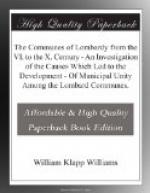These results could hardly have been attained if society had remained such that the prominence of the local divisions was dependent on the prominence of the respective heads of these divisions; but the character of their local rulers once changed, and their powers in a great measure absorbed by the act of a strong central power, when that power fell to pieces it was much easier for the local divisions, as such, to increase their independence, and to utilize the advance they had made, by means of their more direct relation to the central power, to gain a position which they would enjoy in spite of the efforts alike of that power and of their old rulers. Such a position would not be reached except by means of great struggles and by passing through a period of great disintegration and of fierce internal strife between opposing factions, such as in the history of the Italian communes is represented by the dark period between the fall of the last of the Carlovingians and the election of the first German emperor as king of Italy; but once attained, the character of the people who accomplished it would ensure its permanence, as long as they retained those principles of independence which had made them victorious in the struggle. After this short discussion, in which we have traced the ultimate effects of the action of Charlemagne in changing the dukes into counts, let us look at another feature in the field of city government introduced by him, the new office of the scabinus or city judge.
According to the theory of judicial procedure among the Teutonic nations, judgment in criminal cases was given in the open court or placitum, where, besides the regular judges, all or any of the freemen within its jurisdiction were supposed to concur in the judgment and sentence. How far this method of arriving at judicial decisions was carried out in practice depended largely on custom and other local influences, and consequently varied greatly in different countries and with different nations. I do not propose to enter into the discussion[58] of the existence of these “judicators"[59] in Lombardy in the eighth century, but will only say that it is certain that before the Frankish conquest there did not exist a class of men whose business it was to assist the judge in disposing of cases. If through ignorance of the law or for other reasons he was unable to come to a decision, “si vero talis causa fuit, quod




